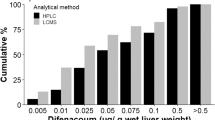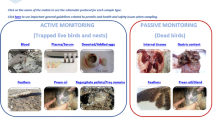Abstract
Raptor population growth is dynamic and trends vary across species and by location in the United States. For those species that are declining, it is important to identify potential causes including chemical contaminants. Sampling wild raptors is problematic due to their small population sizes and role as a top predator. Therefore, we obtained liver samples (n = 56) from carcasses of several raptor species, including common species like red-tailed hawks, red-shouldered hawks, barred owls, great horned owls, and osprey that arrived dead or were euthanized from a non-profit rehabilitation center in Charlotte, North Carolina. Raptors were found or collected in South Carolina, North Carolina, and Virginia, but most samples were located near the metropolitan region of Charlotte, NC. We analyzed livers for total mercury residue (mg/kg, dry weight) and five anti-coagulant rodenticides (μg/kg wet weight). Mercury was analyzed using a direct mercury analyzer approach and rodenticides were quantified by LC-MS. Mercury residues were high in piscivorous birds (15.09 mg/kg for osprey and 6.93 mg/kg for great blue herons, dry weight) and relatively high in red-shouldered hawks and one eastern screech owl tested. Six of our samples exceeded a health threshold of 1 mg/kg (wet weight) including three osprey and one each of great blue heron, red-shouldered hawk, and eastern screech owl. Brodifacoum was the only rodenticide consistently detected in our samples. Brodifacoum detections exceeded 75% in barred owls, great horned owls, and red-shouldered hawks. Sixty-nine percent of owl samples were within (or exceeded) a threshold of brodifacoum residue associated with a 10–20% risk of acute toxicity. Correlations between residues and human population density were not significant for either mercury or brodifacoum. Our data suggest that mercury residues for most raptors were not of significant concern with the exception of osprey and possibly red-shouldered hawks. Rodenticide exposures associated with a risk of acute toxicity appear to be common and warrant further investigation.



Similar content being viewed by others
References
Ackerman JT, Eagles-Smith CA, Herzog MP, Hartman CA, Peterson SH, Evers DC, Jackson AK, Elliott JE, Vander Pol SS, Bryan CE (2016) Avian mercury exposure and toxicological risk across western North America: a synthesis. Sci Total Environ 568:749–769
Albert CA, Wilson LK, Mineau P, Trudeau S, Elliot JE (2010) Anticoagulant rodenticides in three owl species from western Canada, 1988–2003. Arch Environ Contam Toxicol 58:451–459
Belthoff JR, Sparks EJ, Ritchison G (1993) Home ranges of adult and juvenile eastern screech owls: size, seasonal variation, and extent of overlap. J Raptor Res 27:8–15
Bloom PH, McCrary MD, Gibson MJ (1993) Red-shouldered hawk home range and habitat use in southern California. J Wildl Manag 57:258–265
Christensen TJ, Lassen P, Elmeros M (2012) High exposure rates of anticoagulant rodenticides in predatory bird species in intensively managed landscapes in Denmark. Arch Environ Contam Toxicol 63:437–444
Cox P, Smith RH (1992) Rodenticide ecotoxicology: pre-lethal effects of anticoagulants on rat behaviour. Proc 15th Vertebr Pest Conf:165–170
van den Brink N, Elliott JE, Shore RF, Rattner BA (2018) Anticoagulant rodenticides and wildlife. Springer, Cham, Switzerland
Fallacara DM, Halbrook RS, French JB (2011) Toxic effects of dietary methylmercury on immune function and hematology in American kestrels (Falco sparverius). Environ Toxicol Chem 30:1320–1327
Goodrich LJ, Smith JP (2008) Raptor migration in North America. State of North America’s birds of prey. Ser Ornithol 3:37–149
Goodrich LJ, Barber D, Farmer C (2012) What banding tells us about the movement ecology of raptors. J Raptor Res 46:27–35
Hindmarch S, Elliott JE (2015) A specialist in the city: the diet of barn owls along a rural to urban gradient. Urban Ecosyst 18:477–488
Hopkins WA, Hopkins LB, Unrine JM, Snodgrass J, Elliot JD (2007) Mercury concentrations in tissues of osprey from the Carolinas, USA. J Wildl Manag 71:1819–1829
Howell DL, Chapman BR (1997) Home range and habitat use of red-shouldered hawks in Georgia. Wilson Bull 109:131–144
Hughes J, Sharp E, Taylor MJ, Melton L, Hartley G (2013) Monitoring agricultural rodenticide use and secondary exposure of raptors in Scotland. Ecotoxicol 22:974–984
Lohr MT (2018) Anticoagulant rodenticide exposure in an Australian predatory bird increases with proximity to developed habitat. Sci Total Environ 643:134–144
Potter KE, Watts BD, La Guardia MJ, Harvey EP, Hale RC (2009) Polybrominated diphenyl ether flame retardants in Chesapeake Bay region, USA, peregrine falcon (Falco peregrinus) eggs: urban/rural trends. Environ Toxicol Chem 28:973–981
R Core Team (2015) R: a language and environment for statistical computing. R Foundation for Statistical Computing, Vienna, Austria. https://www.R-project.org/
Rattner BA, Horak KE, Warner SE, Day DD, Meteyer CU, Volker SF, Eisemann JD, Johnson JJ (2011) Acute toxicity, histopathology, and coagulopathy in American kestrels (Falco sparverius) following administration of the rodenticide diphacinone. Environ Toxicol Chem 30:1213–1222
Rattner BA, Lazarus RS, Elliott JE, Shore RF, van den Brink N (2014) Adverse outcome pathway and risks of anticoagulant rodenticides to predatory wildlife. Environ Sci Technol 48:8433–8445
Riley SPD, Bromley C, Poppenga RH, Uzal FA, Whited L, Sauvajot RM (2007) Anticoagulant exposure and notoedric mange in bobcats and mountain lions in urban Southern California. J Wildl Manag 71:1874–1884
Sanchez-Barbudo IS, Camarero PR, Mateo R (2012) Primary and secondary poisoning by anticoagulant rodenticides of non-target animals in Spain. Sci Total Environ 420:280–288
Sauer JR, Hines JE, Fallon JE, Pardieck KL, Ziolkowski Jr DJ, Link WA (2014) The North American breeding bird survey, Results and Analysis 1966–2013. Version 01.30.2015
Shore RF, Pereira MG, Walker LA, Thompson DR (2011) Mercury in nonmarine birds and mammals. In: Beyer WN, Meador JP (eds) Environmental contaminants in biota: interpreting tissue concentrations. CRC Press, Florida, pp 609–624
Spalding MG, Bjork RD, Powell GVN, Sundlof SF (1994) Mercury and cause of death in great white herons. J Wildl Manag 58:735–739
Stansley W, Cummings M, Vudathala D, Murphy LA (2014) Anticoagulant rodenticides in red-tailed hawks, Buteo jamaicensis, and great horned owls, Bubo virginianus, from New Jersey, USA, 2008–2010. Bull Environ Contam Toxicol 92:6–9
Stone WB, Okoniewski JC, Stedelin JR (2003) Anticoagulant rodenticides and raptors: recent findings from New York, 1998–2001. Bull Environ Contam Toxicol 70:34–40
Thomas PJ, Mineau P, Shore RF, Champoux L, Martin PA, Wilson LK, Fitzgerald G, Elliot JE (2011) Second generation anticoagulant rodenticides in predatory birds: probabilistic characterisation of toxic liver concentrations and implications for predatory bird populations in Canada. Environ Int 37:914–920
USEPA (2007) Method 7473: mercury in solids and solutions by thermal decomposition, amalgamation, and atomic absorption spectrophotometry, test methods for evaluating solid waste, physical/chemical methods (SW-846), Office of Solid Waste, Washington, DC
Wiemeyer SN, Lamont TG, Lock LN (1980) Residues of environmental pollutants and necropsy data for Eastern United States Ospreys, 1964–1973. Estuaries 3:155–167
Wolfe MF, Schwarzbach S, Sulaiman RA (1998) Effects of mercury on wildlife: a comprehensive review. Environ Toxicol Chem 17:146–160
Zillioux EJ, Porcella DB, Benoit JM (1993) Mercury cycling and effects in freshwater wetland ecosystems. Environ Toxicol Chem 12:2245–2264
Acknowledgements
LCMS analysis made possible by an NSF-MRI Grant (CHE-1624377) to DNB. We thank several students who helped with necropsies of raptors over the years including H. Williams, J. Doughty, and M. Weeks. We also thank A. Ball for help with sample preparation and cleanup for rodenticide analysis and F. Cardenas for help with sample preparation for mercury analysis. We thank two anonymous reviewers for helpful feedback that improved this manuscript
Funding
Funding for this research came from the Carolina Bird Club research grant to SMW and JFT.
Author information
Authors and Affiliations
Corresponding author
Additional information
Responsible editor: Philippe Garrigues
Electronic supplementary material
ESM 1
(PDF 175 kb)
Rights and permissions
About this article
Cite this article
Weir, S.M., Thomas, J.F. & Blauch, D.N. Investigating spatial patterns of mercury and rodenticide residues in raptors collected near the Charlotte, NC, USA, metropolitan area. Environ Sci Pollut Res 25, 33153–33161 (2018). https://doi.org/10.1007/s11356-018-3229-y
Received:
Accepted:
Published:
Issue Date:
DOI: https://doi.org/10.1007/s11356-018-3229-y




